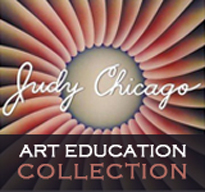Relationship of Chicago/Woodman’s Participatory Art Pedagogy to Other Forms of Feminist Art Pedagogies
Feminist pedagogy, sometimes referred to as “feminist liberatory education,” places issues of power as a central theme. Power is implicated in teacher-student relationships, in access to opportunities, and in self-realization. Many feminist pedagogues (e.g., Kimmel, hooks) emphasize social responsibility, taking ideas into action, and political struggle as important aspects of feminist pedagogy. Feminist art pedagogues seek to empower students to create societal knowledge through self-representations that confront gender, race, economics, age, health, and education as mediating conditions of representation.
Feminist educators form their pedagogical approach from their particular feminist values adjusted in accordance to a specific context. Maher and Tetreaut (1994) note that student-centered learning is an important feminist teaching strategy in which student learning is constructed “through the interactions of communities of knowers” (Garber, 2003, p. 22). Feminist educators of psychology, Tomlinson and Fassinger (2002), found that “one common ingredient within feminist pedagogy is an intentional focus on women, women’s oppression, and/or gender relations” (p. 38). They argue that feminist pedagogy is built on “feminist principles of shared leadership, attending to process, and valuing all voices” (Tomlinson & Fassinger, 2002, p. 38). Feminist art educator, Elizabeth Garber states “while scholarship on feminist pedagogy emphasizes personal experience as part of mastery, expertise, and voice, experience tells me that this is most successful when the teacher is comfortable with her or his mastery and authority of the content” (2003, p. 66).
From a comprehensive review of feminist pedagogical literature in feminist journals and books, Linda Forrest and Freda Rosenberg (1997) concluded that feminist pedagogy is “the fusion of feminist values into the process and methods of teaching” (p. 179). According to Tomlinson and Fassinger’s (2002) survey of feminist educators, they found that feminist teaching practices value and draw out personal experience for personal growth. In contrast Judy Chicago emphasizes the transformation of personal experience into content-based expression that is a tangible form. While most feminist educators privilege process over content, according to the survey, for Judy Chicago the process is valuable to the degree it helps to make tangible works of art. Similar to the feminist pedagogues surveyed, Chicago supports honest expression of emotions, including those by the facilitator or teacher. However, she is opposed to teacher as “mommy,” who is expected to make everything better. Chicago does not align with feminist pedagogy that coddles students and instead is honest and direct in her critiques to prepare students for professional art practice.
Chicago believes in feminist pedagogical practices of non-hierarchical classrooms and assessment strategies, multiple perspectives, diversity in ways of producing knowledge, and social action. Like others, she stresses transforming dominant power relations is a central goal of feminist pedagogy (Lather, 1991; Ellsworth, 1992; Manicom, 1992; hooks, 1994; Forrest & Rosenberg, 1997; Tomlinson & Fasssinger, 2002).
Feminist art pedagogues in the 1970s initially focused teaching on the inclusion of women artists as role-models and to encouraged women to express in visual form their lived-experiences. Second wave feminist art educators guided their students to look for contradictions between socially expected gender roles and their everyday desires, hopes, and experiences. Since the 1990s, feminist art educators have increasingly included content about the diversity of women’s experiences of oppression, power, and privilege; and draw attention in their teaching to issues of gender, race, age, sexual orientation, social class, and education as co-creating this diversity.
When Judy Chicago went back to teaching in 1999 she made a conscious decision to include both men and women in the courses and projects that she and Donald Woodman facilitated. A central tenet of feminist pedagogy is that knowledge is not value-free, therefore teaching is always a political act when one is aware that choice of teaching approach impacts learners in specific ways. Chicago’s decision on mixed gender projects is a political act to teach men to listen to women and to teach women to speak out and with conviction when men are present. She found this worked best when the ratio was two-thirds women and one-third men in the group. Similarly, The Envisioning the Future (ETF) participants included 46 women and 16 men. However, the ETF project was purposefully planned to be a 50/50 gender mix of facilitators to challenge the methodology to build group support structures that encourage all to reach for excellence in completing work.
Read more:
1/ Overview
2/ Chicago/Woodman Teaching Methodology
3/ Relationship of Chicago/Woodman’s Participatory Art Pedagogy to Other Forms of Feminist Art Pedagogies
4/ Relationship of the Participatory Art Pedagogy to Other Art Teaching Approaches
5/ References & Copyrights

Leave a Reply
You must be logged in to post a comment.